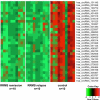Impact of Diminished Expression of circRNA on Multiple Sclerosis Pathomechanisms
- PMID: 35720271
- PMCID: PMC9203966
- DOI: 10.3389/fimmu.2022.875994
Impact of Diminished Expression of circRNA on Multiple Sclerosis Pathomechanisms
Abstract
Circular RNA (circRNA) molecules represent a novel and unique class of endogenous non-coding RNAs controlling the expression and function of microRNA (miRNA) and post-transcriptional regulation. Recent studies implicated circRNA in the pathomechanism of multiple sclerosis (MS). Hybridization microarray was used to define the circRNA profile in the peripheral blood mononuclear cells (PBMCs) from 20 untreated patients with relapsing-remitting MS (RRMS: 10 in relapse, 10 in remission) and 10 healthy controls (HCs). We analyzed close to 14,000 individual circRNAs per sample. The discovery set data were validated using quantitative reverse transcription-polymerase chain reaction (qRT-PCR) with an independent cohort of 45 RRMS patients (18 in relapse, 27 in remission) and 27 HCs. Microarray analysis revealed 246 circRNAs differentially downregulated (P < 0.05) in RRMS patients versus HCs. We validated two circRNAs of the three showing the lowest levels of differential expression in the RRMS remission group versus the HC group: hsa_circRNA_101145 and hsa_circRNA_001896. Their expression was significantly decreased during remission in RRMS (P = 0.0000332, FC = 0.385 and P = 0.0455, FC = 0.591, respectively) and in patients showing a lower level of disability (hsa_circRNA_101145, P = 0.0695; hsa_circRNA_001896, P = 0.0008). Bioinformatic analysis revealed 10 miRNAs interacting with these circRNAs in a complementary manner and led to the discovery of three protein-coding mRNAs downregulated in patients with RRMS during remission. These transcripts have been previously implicated in oxidative stress, blood-brain barrier permeability, microglia function, and extracellular matrix molecules altering the microenvironment and inhibiting oligodendrocyte progenitor cells. circRNAs displayed a distinct profile in PBMCs from patients with RRMS, and our results may implicate circRNAs with low expression in important mechanistic pathways of RRMS.
Keywords: RNA–RNA interactions; biomarkers; circular RNA; multiple sclerosis; non-coding RNA.
Copyright © 2022 Mycko, Zurawska, Selmaj and Selmaj.
Conflict of interest statement
The authors declare that the research was conducted in the absence of any commercial or financial relationships that could be construed as a potential conflict of interest.
Figures





References
Publication types
MeSH terms
Substances
LinkOut - more resources
Full Text Sources
Medical
Molecular Biology Databases

